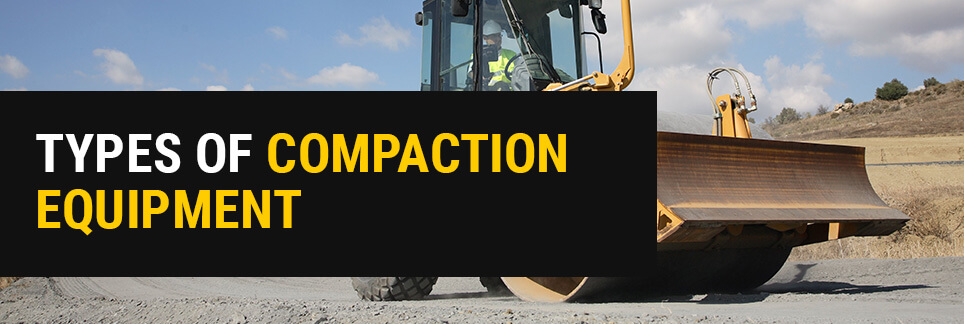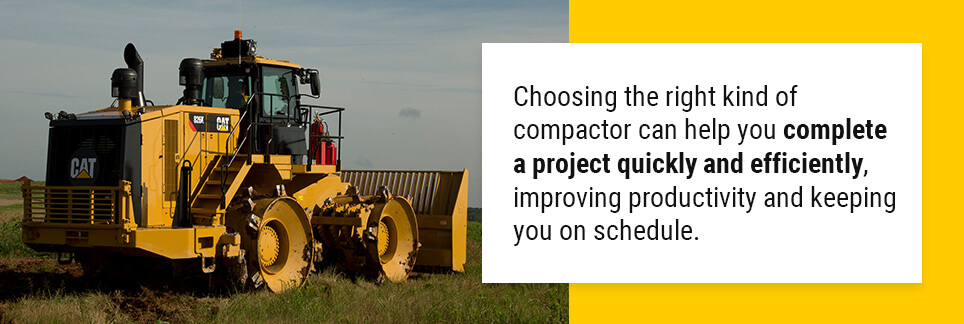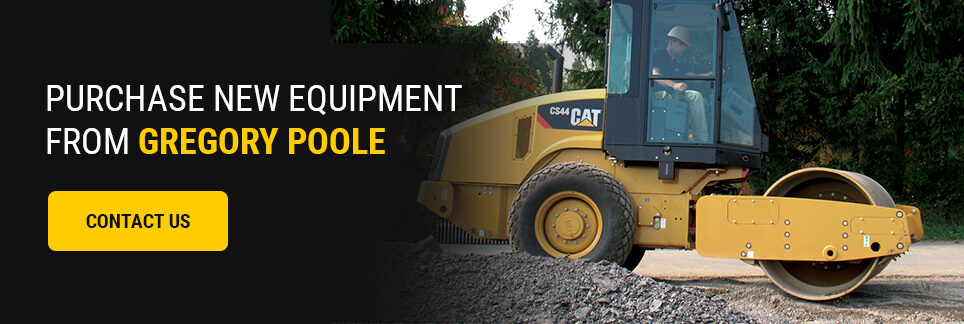
Compaction equipment is available in several types, each with different features for handling specific applications. The best compactor depends on the material needing compaction, the area size and other project-specific factors. Although there are multiple kinds of compaction machines, they all apply downward pressure on a material to compress it and fill in empty spaces. Compaction equipment can also help create an even, level surface so it’s safer to bring other equipment into the area.
Learn more about the various compaction equipment types and the substrate materials they handle well to determine which machine is best suited for your application or project.
Compaction equipment compresses substrate materials like soil, gravel and asphalt to make them denser and more stable. Reducing air voids within a base material prevents future settling and keeps groundwater from seeping up through the substrate. It also increases its durability, strength and load-bearing ability. Compaction is essential for creating strong, stable foundations for all kinds of projects.
In general, granular soil, gravel and sand are best compacted with vibratory equipment, which lets the particles bounce, twist and fall into a position that allows the least movement. However, cohesive soil, clay and silt compress better with impact force, which pushes out air and water between the small particles.
Using heavy equipment allows efficient compaction with minimal effort from workers. Some of the many uses of compaction equipment include:
There are three main compaction equipment types — plate, rammer and roller. Additionally, a compactor can be hand-operated, a dedicated piece of machinery or an attachment for other heavy equipment. Choosing the right kind of compactor can help you complete a project quickly and efficiently, improving productivity and keeping you on schedule.

Here are the most common types of equipment used for compaction:
Also called vibratory soil compactors, vibrating plate compactors or vibratory tampers, this equipment compacts soil with a vibrating plate. They are often hand-operated, walk-behind machines that are best for small areas like trenches, sidewalks or against walls. However, plate compactor attachments are much larger, with plates varying from 1.5 to 17 square feet. Plate compactors are best suited for coarse, granular soil and asphalt.
These light soil compactors have plates attached to springs and pistons that move them up and down with high force. Rammers or jumping jack tamps are generally hand-operated and powered by a gas or diesel engine. Their small plates are between 36 and 64 square inches. This smaller size makes them ideal for areas with difficult access, such as around pipes. They are best for compacting rock fragments and cohesive and semi-cohesive soil.
These hand-operated compactors are also called self-propelled rollers or trench rollers. They often feature one roller that is generally 2-3 feet wide, though larger models can have two rollers. Walk-behind rollers are appropriate for medium-sized areas such as building foundations. They often work best on substrates that don’t require a lot of pressure. However, whether the drum is smooth or textured also affects what materials are suitable.
Smooth wheel rollers are large machines with multiple static steel drums instead of wheels. They often have one wider roller in the front and two narrow rollers in the back. Because these machines have smooth steel drums instead of tires, they have very little traction. This lack of traction can be a safety hazard, especially on wet surfaces. While smooth wheel rollers can weigh up to 11 tons (22,000 pounds), they are best for soil that doesn’t need intense pressure. These machines are appropriate for cohesive soil, gravel, crushed rock, graded sand and asphalt.
Vibratory rollers typically have one smooth roller at the front and standard tires on the back. Additionally, they use reciprocating or rotating mass to vibrate the drums. These machines are suitable for fine-grained soil, asphalt and sand-gravel mixes. Compared to static rollers, vibratory rollers offer higher-density compaction to greater depths with less work. Though they are typically more expensive than static rollers, their improved efficiency, performance and output make them a worthwhile investment. Vibratory rollers are also available as attachments for other machines.
As their name implies, textured wheel rollers feature steel drums with protrusions instead of smooth rollers. They are available in static or vibratory options and generally have one roller up front and tires at the back. Depending on the texture, these rollers can work on many different kinds of surfaces, such as clay, sand-gravel mixes, weathered rocks and coarse soil. Specific types include sheepsfoot rollers, elephantsfoot rollers, pad foot rollers and grid rollers.
Tandem rollers, sometimes called utility compactors, have one steel drum in the front and one in the back. They are available with static or vibratory drums. Since they have two rollers, they are often more efficient than other machines and can achieve the same level of compaction in fewer passes. When they have smooth drums, they don’t have good traction and can become hazardous on wet surfaces.
Here are a few less common kinds of compacting equipment you might see available:
Whether you’re doing construction, roadwork or landscaping, the experts at Gregory Poole Equipment Company can help you find the right equipment for your situation. We have extensive experience with heavy equipment and provide top-notch services. You can count on us for high-quality machinery, maintenance and ongoing support.
We have a large selection of new compactors and used equipment for sale from top brands like Cat®, Weiler, Comaco and Etnyre. We also offer compactors for rent if you want to try a machine before committing to a purchase or only need it for a limited time. Browse our stock online, or contact us for a free quote or more information.
